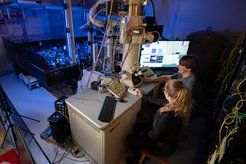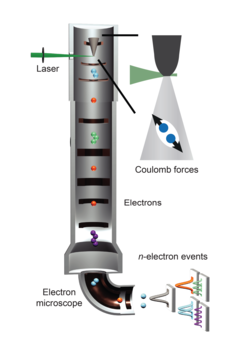Interplay of free electrons
Tailored electron pulses for improved electron microscopy
Electron microscopes provide unique vistas of nanoscale structures from biology to materials research. However, their resolution is limited, among other things, by the mutual repulsion of the electrons in the imaging beam. Scientists at the Max Planck Institute (MPI) for Multidisciplinary Sciences in Göttingen have now succeeded in precisely measuring the influence of these Coulomb forces: For the first time, they produced tailored electron pulses with exactly two, three, or four electrons and observed how their interaction affects their velocities. They discovered an “energetic fingerprint” in which the distribution of the electrons’ velocities is characteristic of their respective numbers. This finding has enabled the researchers to develop a method for generating pulses with a given number of electrons. The results of the study have implications for well-established electron microscopes and enable new measurement techniques based on correlated electrons.

Our understanding of nanoscale phenomena largely rests on the performance of modern microscopy. For example, transmission electron microscopes routinely achieve atomic resolution nowadays. In these microscopes, electrons are sent through an object under investigation to obtain an image – in some analogy to a light microscope. Thereby, electron microscopes can visualize molecular structures, the atomic ordering in solids, and the shape of nanoparticles.
However, the contrast and resolution of electron microscopes is limited, among other things, by interactions between electrons: when two electrons come close to each other, they mutually repel due to the Coulomb force. This limits the maximum usable brightness of an electron beam. Researchers led by Claus Ropers, director at the MPI for Multidisciplinary Sciences, have now resolved and analyzed the repulsion between individual electrons in the microscope for the first time. Using the new insights, they developed methods that make use of this interparticle repulsion.
Counted electrons

“Electrons in a beam are randomly distributed. Therefore, one cannot control the inaccuracies introduced by Coulomb forces,” says Rudolf Haindl, first author of the study recently published in the science magazine Nature Physics. But when the physicists use a laser to generate electrons in the form of ultrashort pulses, they also create packets with exactly two, three, or four electrons. These electrons are closely confined in space and time such that they interact with each other. With the help of a spectrometer and an event-based detector, the energy exchange between electrons in a pulse becomes visible. “Depending on how many electrons are in a pulse, the electrons repel each other to different degrees. This allowed us to determine an energetic fingerprint for the number of electrons in a pulse,” Haindl points out.
New possibilities

Based on their findings, the team developed new schemes to use the multi-electron states in electron microscopes. “We have worked out a procedure that will enable us to generate electron pulses with a fixed number of electrons in the future. This can significantly increase the performance of electron microscopes in basic research and technology applications, for example in semiconductor manufacturing,” explains Armin Feist, co-author and physicist in Ropers’ team.
Max Planck Director Ropers adds, “In addition to the implications for electron microscopy and lithography, we believe that the electrons are also quantum mechanically ‘entangled’, tied to each other in a specific quantum way, which opens up a new interface between electron microscopy and quantum technology.” (kr/jpy)














